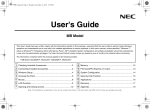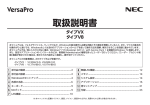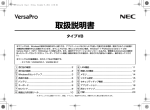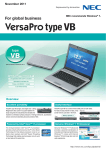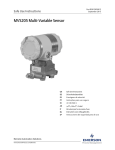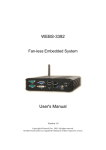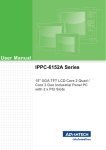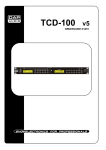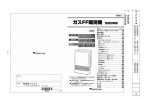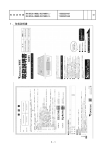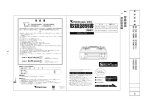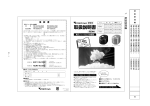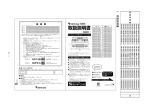Download User`s Guide
Transcript
User's Guide
VX Model
VB Model
This User's Guide has been written assuming that the user is familiar with terms used for basic Windows operation such as "folder", "file", or
"window". It also assumes that the user is able to perform basic mouse operation and understands how to use help in Windows or its installed
applications to resolve problems.
In this user's manual, unless separately specified, "Windows 7" refers to genuine Windows® 7 Professional 32 bit with Service Pack 1 installed.
System configuration and software installation should be conducted by a user who has administrator privileges. If a [User Account Control]
screen comes up, please be sure to confirm the contents before continuing.
The information contained within this manual applies to the following models:
• VX Model: VC25M/X-D, VG25M/X-D
• VB Model: VC17H/BB-D, VG17H/BB-D
1
2
3
4
5
6
7
Checking Included Accessories..............................................2
Connecting Included Accessories...........................................2
Windows Setup.......................................................................4
Knowing the Parts...................................................................6
Keyboard.................................................................................9
The NX Pad............................................................................9
8 Wireless LAN Function......................................................... 12
9 Memory................................................................................. 14
10 System Configuration............................................................ 14
11 Applications.......................................................................... 16
12 Recovery...............................................................................21
13 Appendix...............................................................................23
LAN Function........................................................................ 10
Note: The illustrations, screenshots, icons, and on-screen text shown in this document may differ from the ones you actually encounter.
取扱説明書-853810602418A.indd
1
2011/11/14
9:38:00
1
Checking Included Accessories
Checking that all included accessories are present
保修书
*1
*1
安全使用说明
Instructions For Safe Use
NEC软件的使用条件
【即EULA】
(对顾客的特别提示)
(请务必先仔细阅读如下内容后,决定是否打开本个人电脑的包装)
Terms and Conditions for using software (For Customer)
(Please read this before opening the package) *2
Base unit
Power cord
AC adapter
Battery pack
Application Disc
Recovery Disc
User's Guide
Connecting Included Accessories
Important points when connecting
Please open up the box and check that all included items and accessories are
there. Please immediately contact the place of purchase if any items happen to
be missing or damaged.
1. Check contents of the box.
2
O O Do not touch connector terminals when connecting any items.
Failure to do so may cause damage.
O O Confirm that the wireless LAN is turned off.
In the default factory settings, the wireless LAN is turned off.
onnect the LAN cable or turn on the wireless LAN, only after
OO C
completing Windows setup and firewall configuration.
This ensures that your computer can be safely connected to a network.
Connecting power sources
*2
1. Install the battery pack.
*1
Please install the battery pack according to the following illustration.
VX Model
Prong
2
1
3
*1 : VC25M/X-D, VC17H/BB-D
*2 : VG25M/X-D, VG17H/BB-D
2. Confirm that the model number and serial number on the base unit
matches the model number and serial number written on the warranty.
If they happen to differ, please contact the place of purchase immediately.
Please also keep your written warranty in a safe place for future reference.
If your encounter a breakdown during the warranty period, we shall provide
repairs based on the conditions specified in the warranty. For repairs after the
warranty period has expired, please consult the place of purchase or one of
our specified customer service locations. If it is deemed possible to regain
functionality, we are able to perform paid repairs at the customer's request.
Guide
Battery eject lock
VB Model
1
Battery eject lock
Guide
3
2
Battery eject lock Battery pack
Groove
2
取扱説明書-853810602418A.indd
2
2011/11/14
9:38:01
2. Connect the AC adapter.
B
attery pack removal
VX Model
2
• After purchase, be sure to fully charge the battery before use.
• Do not remove the AC adapter before Windows setup has completed.
Battery eject lock
1
Battery unlock
3
1
2
3
Insert the AC adapter into the power input jack (
).
Connect the power cord to the AC adapter.
Insert the other end of the power cord into a wall outlet.
When the AC adapter is connected, the battery will start to recharge and the
) will turn orange.
battery recharge indicator (
Once the battery is fully charged, the battery recharge indicator (
) will turn
off.
Depending on battery charging conditions, there are some cases where the
battery recharge indicator (
) does not illuminate. This happens when the
battery has been charged to at least 95% capacity.
VB Model
Battery eject lock
2
1
Battery unlock
3
3
取扱説明書-853810602418A.indd
3
2011/11/14
9:38:02
3
Windows Setup
If two-byte characters, environment-dependent characters, or certain symbols
are used for any part of the user name or computer name, Windows setup may
not be completed, or some applications may not run correctly.
Therefore, it is important that the user name and computer name only includes
single-byte alphanumeric characters and does not contain any symbols or
spaces. The length is also limited to 20 characters.
When you first power up your new computer, it is necessary to perform
Windows setup.
Never turn off the power during Windows setup. Turning off the power switch or
pulling out the power cord in the middle of this process may lead to damage.
If there is some sort of problem or you accidentally press the power switch,
please see "If you encounter problems during setup" on p.5.
Turning on the power
1
Important points during setup
O O Always follow the procedure written in the manual.
Setup may not be able to be successfully completed if you omit any steps,
press any keys other than the ones indicated on the screen, or operate any
switches.
O O Do not connect any external peripherals.
Never connect any peripherals (printers, memory, etc.) other than the items
outlined in "2 Connecting Included Accessories". Please connect or install
such peripherals after "3 Windows Setup" had been completed.
O O Do not connect a LAN cable and make sure that the wireless LAN is
turned off.
To ensure safe network connection, only connect a LAN cable or turn on
the wireless LAN after Windows setup and firewall configuration has been
completed.
Be sure to also confirm that the wireless LAN is turned off. (In the default
factory settings, the wireless LAN is turned off.)
O O Do not leave the computer alone during setup.
Do not leave the computer unattended until Windows setup has completed
including passing all the screens which require your key operations, and
power OFF.
Preparation for setup
During Windows setup, you are required to enter the name of the person who
will be using the computer (user name), as well as the computer name. Please
choose these names in advance.
Open the computer lid.
Please securely support the keyboard side when opening and closing the LCD
display. In order to prevent excess force from being directly applied to the LCD
screen, please handle the screen around the border area.
2
Press the power switch (
).
Setup Procedure
Start Windows 7 setup.
• You may have to wait for some time for the [Windows 7 Professional] screen
to come up.
• During setup, some parts of the screen may turn black. However, this does
not necessarily mean that there is a problem.
• Please contact your system administrator for appropriate settings during steps
1 to 3, 6, and 7.
1
2
Once the [Windows 7 Professional] screen comes up, please select
your preferences for the [Country or region], [Time and currency],
and [Keyboard layout] and click [Next] to continue.
Enter your user name and computer name when prompted and click
[Next] to continue.
Setup cannot progress to the next step unless you enter a valid user name and
computer name.
3
4
4
取扱説明書-853810602418A.indd
4
Enter a user account password when prompted and click [Next] to continue.
Please check the contents when the [Please read the license terms]
page is displayed.
2011/11/14
9:38:02
5
After checking the contents, check [I accept the license terms] and
click [Next] to continue.
6
7
If you do not accept the license terms, setup cannot continue.
6
7
When the [Help protect your computer and improve Windows
automatically] page is displayed, please select either [Use recommended
settings], [Install important updates only], or [Ask me later].
When the [Review your time and date settings] page is displayed, please
select your time zone date, and time, and click [Next] to continue.
The screen should change several times during this process, and it may
take some time before the desktop is displayed.
8 When a dialog box comes up asking you to shut down, click [OK].
9 Click [Start].
10 Click [Shutdown].
Press the <F10> key.
The setup confirmation screen should come up.
Select [Yes] and then press <Enter>.
The BIOS setup utility should now be finished and Windows will automatically restart.
After this, please see "Setup Procedure" on p.4 and continue on with the process.
If you accidentally turn off the power during setup
The setup process will not be successfully completed and Windows system
files or the registry may be corrupted.
In this case, either perform Windows recovery or consult your place of purchase.
The computer is unresponsive or shows an error message during setup.
Make a note of the error message and hold down the power switch for at least four
seconds to perform a forced shutdown.
Please wait for at least five seconds before turning the power switch back on. After
that, please see the above "If you accidentally turn off the power during setup".
Using and configuring your computer after setup is complete
The computer power will then turn off.
Creating multiple hard disk partitions
After Windows setup has completed, Windows Experience Index measurements
are performed once your computer continues to be in an idle state for around 15
minutes. While these measurements are in progress, the power plan will change to
"High performance". At this time, you may notice the power to the display cutting out.
If you encounter problems during setup
The setup screen is not displayed.
When [Press <F2> to Enter BIOS Setup] is displayed on the screen when you
turn the power on, please carry out the following procedure.
Press the <F2> key.
The BIOS setup utility will then be displayed.
1
As a default setting, the first internal hard disk has only one useable partition
(volume), designated as the C: drive.
However, it is possible to divide the C: drive into multiple partitions.
Please refer to the following steps if you would like to change the factory
default settings and reduce the size of the C: drive in order to create a new
partition from the resulting unassigned space.
1 Open [Control Panel].
2 Click [System and Security] and then [Administrative Tools].
3 Double click [Computer Management].
4 On the tree displayed on the left side of the window, click [Storage]
[Disk Management].
5
6
7
Select the volume marked as (C:) and right click it.
Click [Shrink Volume].
Enter the desired size into the [Enter the amount of space to shrink
in MB:] box.
he size entered here will become the maximum size of the newly created
T
partition.
2
Use the number keys to enter the current hour (24 hour time format)
and then press <Enter>.
3
Use the <Tab>, < >, and < > keys to move to desired position and in the
same manner, set the rest of the time and date in the order of minutes,
seconds, month, day, and year.
4
Press the <F9> key.
The setup confirmation screen should come up.
8
9
Select [Yes] and then press <Enter>.
The BIOS setup utility will then be displayed.
10 Click [New Simple Volume].
5
取扱説明書-853810602418A.indd
5
Click [Shrink].
After shrinking is complete, select the unassigned space that has
been reserved, and right click it.
5
2011/11/14
9:38:02
11 Click [Next].
12 Enter the desired volume size into the [Simple volume size in MB:]
4
box and click [Next].
13 Confirm that [Assign the following drive letter:] is selected and click [Next].
14 Confirm that [Format this volume with the following settings:] is
selected and click [Next].
15 Click [Finish].
Names and descriptions of your computer's major components
The front and right sides.
VX Model
(1)
(2)
• Do not select [Mark Partition as Active] for the newly created partition.
Marking this partition as active will cause the computer to use that partition for
the boot loader, marking it as the partition to boot the operating system from.
• It is not possible to shrink a "Recovery Partition".
• It is possible to change the drive letter if necessary.
• Depending on the system environment, there may be some cases where
"Shrink Volume" is not possible. For more information about shrinking
a volume, please refer to "Shrinking a Basic Volume" in the "Computer
Management" help file.
Disk management usage instructions "Disk Management" help.
Knowing the Parts
(6)
(4)
(1)
(4)
(27)
(5)
(3) (6)
(2)
(7)
(8)
(24)
VB Model
(5)
(7)
(8)
(15)
(10)
(21)
(20)
(3)
(2)
(23)
(14)
Creating a system repair disc
We recommend creating a system repair disc for times when problems such as
corrupted files cause Windows to not load correctly, even after running in safe
mode or the last known good configuration.
For more information about creating and using a system repair disc, please
refer to Windows help.
Windows® Update and Microsoft® Update
The latest and import security update information is available through Windows®
Update or Microsoft ® Update. Please run Windows® Update or Microsoft ® Update
regularly to ensure you always have the latest version of Windows installed.
The back and left sides.
VX Model
(21)
(13)
(9)
(28)
(12)
(10)
VB Model
(13)
(14)
(9)
(20)
(10)
(25)
(11)
(10)
(22)
(26)
(12)
(19)
(15)
(11)
(22)
(10)
Your computer has been delivered to with the all current updates already
installed. Please do not attempt to uninstall these updates as it may cause
issues that have already been resolved to reappear.
Windows Service Pack
The version of Windows 7 installed on your computer is "Windows® 7 Service Pack 1
(SP1)" (Hereby referred to as "Windows 7 SP1").
It is not possible to uninstall Windows 7 SP1.
6
取扱説明書-853810602418A.indd
6
2011/11/14
9:38:03
The bottom.
VX Model
VB Model
(18)
(22)
(6)
(22)
(22)
(22)
Number
Name
(15) DC power input (
(16) Memory slot
(17)
(19)
(18)
(16)
(17)
(18)
(16)
(19)
(17)
Explanation of Components
Number
Name
(1)
LCD display
(2)
Status LEDs
(3)
Power switch (
(4)
(5)
(6)
(7)
Explanation
This is the computer's display.
These indicate various states of the computer.
This is used to turn the computer on/off or
)
change the power state.
Keyboard
Used to input characters and to control
programs.
The NX Pad
Used for moving the mouse cursor and clicking
objects in Windows.
Speaker
Built-in stereo speakers.
Microphone input jack A regular microphone can be connected to
provide audio input.
( )
(8)
Line out/Headphone
shared output jack
( )
(9)
Security lock (
(10)
USB port (
)
)
(11)
External display
output (
)
(12)
LAN port (
(13)
(14)
PC card slot
PC card eject button
)
Provides audio output when regular
headphones or an audio system is connected.
A security cable (sold separately) can be
attached to this slot.
This port can be used to connect to USB
devices. It supports both USB 2.0 and USB 1.1.
In order to take advantage of USB 2.0 transfer
speeds, it is necessary to be connected to a
USB 2.0 enabled device.
This is used to allow viewing on externally
connected displays or projectors.
This is used to connect to a LAN (Local Area
Network)
This slot accepts all common PC cards.
Used to remove PC cards from the slot.
(19)
(20)
(21)
(22)
(23)
(24)
(25)
(26)
(27)
(28)
Explanation
) Used to connect to the supplied AC adapter.
This slot is used when installing an expanded
RAM board.
This locks the battery pack in place to prevent it
Battery eject
from falling out. It must be unlocked in order to
lock
remove the battery.
Battery unlock
This is used when you want to remove the
battery pack. Please use it after releasing the
battery eject lock.
Battery pack
This rechargeable battery is used when there
is no access to an AC external power supply.
Wireless switch ( ) This switch turns wireless LAN functionality on
and off.
This is the internal DVD Super Multi drive. (Only
Optical drive
available for the VB model as an optional extra)
It can read DVD data and is able to write to
multiple disc formats such as DVD-R and CD-R.
Air vent
These holes are designed to allow internal heat
to escape.
Avoid covering them with materials such as
hands or clothes.
SD memory card slot This slot accepts SD, SDHC, and SDXC
(VB model)
memory cards.
Volume control knob
This is used to control the volume of the audio
output from the internal speaker or the line out/
(
)
(VX model)
headphone shared output ( ). Rotate it to the
right to raise the volume, and rotate it to the left
to lower it. Pushing this knob can also toggle
the sound on and off.
This is used to connect to devices that have a
Serial port (
)
(VX model)
serial port.
HDMI port
This is used to connect to HDMI compatible
(VX model)
wide-screen televisions or external displays
that are equipped with a HDMI port.
ECO button
This button is used to toggle ECO mode on
(VX model)
and off. The color of the ECO button LED
also indicates which one of three settings is
currently chosen.
Fax/Modem port (VB A telephone line can be connected for data
model)
transmission, etc.
7
取扱説明書-853810602418A.indd
7
2011/11/15
13:50:44
Num Lock indicator LED
Status LEDs
Power LED
LED state
White
On
(VX model)
Blue
Flashing
(VB model)
Orange
On
Flashing*1
Quickly
flashing*2
Off
Computer State
Computer power on
Sleep
Off
Computer State
<Num Lock> is on (Part of the keyboard can be used
as a numeric keypad)
<Num Lock> is off
Wireless LAN indicator LED (VX model only)
Low battery
Low battery during sleep
Extremely low battery
Computer power off, or hibernating
*1: Flashes around once every three seconds.
*2: Flashes around once every two seconds.
LED state
On (Green)
Off
Computer State
Wireless LAN can be used
Wireless LAN cannot be used
SD memory card slot access LED (VB model only)
LED state
On (Green)
Off
Battery recharge LED
LED state
Orange
On
Flashing
Off
LED state
On (Green)
Computer State
The card in the SD memory card slot is currently
being accessed
Not currently being accessed
Computer State
Battery recharging
Battery error *1
The AC adapter is unplugged, or the battery is fully
charged
*1: Battery recharging error, battery life or deterioration error.
Drive activity LED
LED state
On (Green)
Computer State
The hard disk or optical drive is currently accessing
data.
The hard disk or optical drive is not currently
accessing data.
Off
Caps Lock indicator LED
LED state
On (Green)
Off
Computer State
<Caps Lock> is on (All text input is in capital letters)
<Caps Lock> is off (All text input is lowercase letters)
Scroll Lock indicator LED
LED state
On (Green)
Off
Computer State
<Scr Lock> is on
<Scr Lock> is off
8
取扱説明書-853810602418A.indd
8
2011/11/14
9:38:05
5
6
Keyboard
This section covers the NX pad usage and extended feature settings, as well
as the driver update process.
Using the keys
Names and roles of the main components
Hotkeys (Using the function keys)
By pressing the function key <Fn> in combination with another key, you can
easily change common computer settings. These functions are called "Hotkeys".
Key Sequence
VB Model
–
<Fn> + <F1>
<Fn> + <F6>*1
)
<Fn> + <F7>
Decreases the screen brightness (
<Fn> + <F8>
Increases the screen brightness (
–
<Fn> + <F9>
Decreases the volume (
–
<Fn> + <F10>
Increases the volume (
)
–
<Fn> + < >
System request
Page up
–
<Fn> + < >
Page down
–
<Fn> + < >
Home
–
<Fn> + < >
End
*1: This setting is cancelled when the computer is turned off or restarted.
*2: Automatic screen brightness adjustment is turned off when this is used.
Mouse buttons
)
)
Name
Touchpad
Mouse buttons
Scroll lock
Break
Touchpad
Mouse buttons
The role of each part can be shown as follows.
)
<Fn> + <Scr Lock> Num lock
<Fn> + <Pause>
)
Turns the sound on and off (mute) (
<Fn> + <F9>*2
<Fn> + <Prt Scr>
VB Model
Controls the beep sound (
–
VX Model
Scroll button
<Fn> + <F8>*2
<Fn> + <F12>
Touchpad
Function
VX Model
–
The NX Pad
Scroll button
(VX model)
Role
Moving your finger over this pad allows you to control
the mouse pointer.
There are both left and right mouse buttons. The left
button is used as the primary button for clicking. The
right button can bring up the context menu related to the
mouse pointer's location.
When the content to be displayed is too large to fit into
a single window, press the scroll button to scroll up or
down in order to see information that is out of view.
Scroll/zoom using the touchpad
The touchpad can be used to scroll in the left/right and up/down directions, or
zoom in and out.
This cannot be used for applications that do not support scroll or zoom.
Using the touchpad to scroll.
Click on a window that is showing the scroll bar and run your finger along
the far right or bottom edge of the touchpad. This should allow you to scroll
the window in the left/right and up/down directions.
During scrolling, you can also scroll by moving your finger in a circular
motion on the pad (circle scroll).
9
取扱説明書-853810602418A.indd
9
2011/11/14
9:38:05
Using the touchpad to zoom in and out.
Click on the window that you would like to zoom in or out and run your
finger along the far left edge of the touchpad. This should allow you to zoom
in and out.
In the default factory settings, the touchpad zoom function is turned off.
7
LAN Function
This section covers important points and the correct procedure for setting up
the LAN (Local Area Network) function.
LAN settings
The following provides a simple explanation about how to perform network
setup in order to connect to a LAN.
NX pad settings
Configuration of the NX pad buttons, pointer behavior, and extended features is
done using the [Mouse Properties] window.
1 Click [Start] and then [Control Panel].
2 Click [Hardware and Sound].
3 Click [Mouse] under [Devices and Printers].
The [Mouse Properties] window should come up.
Click on each tab in the [Mouse Properties] window to change the NX
pad settings.
Setting up a network connection
Network connection settings can be changed by going to the [Control Panel]
and clicking [Network and Internet] [View network status and tasks]
[Change adapter settings].
For more detailed information, please refer to Windows help.
The following step allows you to change settings such as the computer name.
Setting the computer name and network to connect to
Selecting the name of your computer to be displayed on the network, and
changing other connected network settings can be done by going to the
Control Panel and clicking on [System and Security] [System], and then
selecting [Change settings] under [Computer name, domain, and workgroup
settings].
For more detailed information, please refer to Windows help.
This is all you need to do to correctly setup your LAN.
Remote power on (WoL - Wake on LAN)
Remote Power On (WoL - Wake on LAN) can allow you to do the following.
• Remotely turn your computer on after the power is off.
• Remotely wake up your computer after sleep or hibernate.
If you configure your computer to allow Remote Power On (WoL - Wake on LAN),
the LAN adapter stays active, even when the computer power is off.
A special packet (Magic Packet) that instructs your computer to turn on can be
transmitted from a remote administrator's PC. When this packet is received by
the computer's dedicated controller, it triggers the power to be turned on.
This allows you to be able to remotely turn your computer's power on or wake
it up from sleep or hibernate from an administrator's PC when your computer
has a LAN connection.
10
取扱説明書-853810602418A.indd
10
2011/11/14
9:38:05
• In order to enable Remote Power On (WoL - Wake on LAN), it is necessary to install
special software on the administrator's PC to allow sending of Magic Packets.
• It is not possible to use Remote Power On (WoL - Wake on LAN) in cases where
the previous system shutdown (power off, sleep, or hibernate) was not correctly
completed. If this is the case, please turn the power back on, restart Windows,
and once again perform a system shutdown using the correct procedure.
• Remote Power On (WoL - Wake on LAN) cannot be used with a hub that
only supports a speed of 1000 Mbps. Please use a hub that supports
10M/100M/1000M Auto-negotiation.
• When using Remote Power On (WoL - Wake on LAN), please ensure that the AC
adapter is plugged into your computer when in hibernation or turned off.
• In order to use network booting, it is necessary to first enable it within the
BIOS setup utility, and install separate management software to allow support
for PXE.
• There are some cases where network booting cannot be enabled after
pressing the <F12> key. If this is the case, please try to vary the timing when
pressing the <F12> key.
How to configure your computer to allow Remote power on (WoL - Wake on
Configuring the BIOS setup utility to enable network booting.
Turn your computer on and press <F2> several times as soon as the
NEC logo appears.
The BIOS setup utility will then be displayed.
2 In the [Advanced] menu, set [Network Boot Agent] to [Enabled].
LAN) from when the power is turned off
This is all you need to do to correctly setup network booting.
1
The following steps can be used to configure your computer to allow Remote
Power On (WoL - Wake on LAN) from when the power is turned off.
1 Turn your computer on and press <F2> several times as soon as the
NEC logo appears.
The BIOS setup utility will then be displayed.
2
3
4
In the [Advanced] menu, set [Remote Power On] to [Enabled].
Press the <F10> key.
Confirm that [Yes] is selected and then press <Enter>.
These setting values are saved, the BIOS setup utility will finish, and your
computer will restart.
Configuration is now complete.
How to configure your computer to allow Remote power on (WoL - Wake on
LAN) from sleep or hibernate mode
These settings can be found in [Device Manager] [Network adapters].
For more detailed information, please refer to Windows help.
Network booting function (PXE)
This enables booting via a network, and remote connection to your computer
from an administrator's PC which allows you to do the following.
• Operating system installation
• BIOS flashing (Rewriting the BIOS ROM)
• BIOS configuration changes
To enable network booting, when your computer starts up, press <F12> several
times as soon as the NEC logo appears.
11
取扱説明書-853810602418A.indd
11
2011/11/14
9:38:05
8
Wireless LAN Function
Turning the wireless LAN on/off
The following methods can be used to turn the wireless LAN on and off.
• Turning the wireless LAN on and off with the wireless switch
• Turning the wireless LAN on and off through "Wireless Network Connection"
Your wireless LAN on/off setting is saved, even after the computer power has
been turned off.
Turning the wireless LAN on and off with the wireless switch
Operate your computer's wireless switch to turn the wireless LAN on and off.
Turning the wireless LAN on and off through "Wireless Network Connection"
The wireless LAN can be turned on and off by going to the [Control Panel],
clicking [Network and Internet], and selecting [Change adapter settings] under
[Network and Sharing Center].
For more detailed information, please refer to Windows help.
4
5
Click [Connect] after confirming that the [Connect automatically]
checkbox is selected.
If a window comes up asking for a security key, enter the security
key of the network you are connecting to and click [OK] to continue.
Configuration is now complete.
Important points when using PROSet/Wireless
• Please use a user name consisting of single-byte alphanumeric characters.
• Please change the [Region and Language] to [English (United States)] in
order to install, uninstall, or configure PROSet/Wireless.
Once installation, uninstallation, or configuration has been completed, you
may freely revert to your original settings.
To check or change your [Region and Language] settings, please do the
following.
1
2
Configuring and connecting the wireless LAN
3
The wireless LAN functionality can be configured with the [Power Management]
tab in Driver properties.
Configuring the wireless LAN
4
In the [Control Panel] and click [Clock, Language, and Region] and then
[Region and Language].
If the format is set to anything other than [English (United States)],
select [English (United States)], click [Apply] and continue to step 2.
Click on the [Administrative] tab.
If the [Current language for non-Unicode programs] is set to [English
(United States)], click [OK] to close the window.
This completes the procedure for checking or changing the [Region and
Language] settings.
Click [Change system locale], and under [Current system locale] select
[English (United States)], and then click [OK].
Restart Windows.
This completes the procedure for checking or changing the [Region and
Language] settings.
The following explanation is for connecting to a wireless LAN access point that
broadcasts its network name (SSID).
For information about other connection methods, please refer to Windows help.
1 Confirm that your computer's wireless LAN function is turned on.
2 Go to the [Control Panel] and click [Network and Internet] [Network
and Sharing Center].
C
lick [Connect to a network] under [Change your networking
settings].
A list of network names (SSID) should come up.
3
Click on the network name (SSID) of the wireless network that you
would like to connect to.
12
取扱説明書-853810602418A.indd
12
2011/11/14
9:38:06
Installing PROSet/Wireless
By using PROSet/Wireless with your computer's wireless LAN, it is possible
to use authentication functions (LEAP, etc.) that do not have native Windows
support.
If you would like to use extended features aimed at network administrators,
please refer to ReadMe.txt (C:\DRV\WLINSEV\UTILITY\APPS\ReadMe.txt).
PROSet/Wireless can be installed with the following steps.
Close any other open applications.
Click [Start] and then [All Programs] [Accessories] [Run].
In the [Open] box, enter "C:\DRV\WLINSEV\UTILITY\APPS\Setup.exe
/qn /forcerestart" and click [OK].
1
2
3
• Please note that nothing will be displayed on the screen during installation.
• Windows will automatically restart once installation is complete.
This is all you need to do to correctly install PROSet/Wireless.
Uninstalling PROSet/Wireless
PROSet/Wireless can be uninstalled with the following steps.
1 Close any other open applications.
2 Go to the [Control Panel] and click [Programs] [Uninstall a
program].
3
4
Click [Intel(R) PROSet/Wireless WiFi Software].
Click [Change].
Click [Next] if the [Intel(R) PROSet/Wireless WiFi Software] window comes up.
5
6
7
Select [Remove] and click [Next].
Select [Remove] and click [Next].
The uninstall process should now begin.
Restart Windows once the program has been successfully uninstalled.
This is all you need to do to correctly uninstall PROSet/Wireless.
For more detailed information about PROSet/Wireless, please use the following
steps to view the help information.
Display help information
1
2
Click [Start] and then [All Programs] [Intel PROSet Wireless]
[WiFi Advanced Statistics].
Click [Advanced Statistics Help] in the [Help] menu.
Please see the following steps if you would like to enable wireless management
for Cisco infrastructure.
1
2
3
4
5
Go to the [Control Panel] and click [Network and Internet] [Network
and Sharing Center].
Click [Manage wireless networks] and double click on the profile you
would like to change.
Check the [Enable Intel connection settings] checkbox in the
[Connection] tab and then click [Configure].
Click [Cisco Options] and check the [Enable Radio Measurement]
checkbox. Click [OK] to continue.
Click [OK].
13
取扱説明書-853810602418A.indd
13
2011/11/14
9:38:06
9
4
Memory
Your new memory should now be ready to use.
Installing memory
1
2
Please refer to the following diagram when removing memory.
Remove the battery pack.
Use a Phillips screwdriver to remove the screws shown in the
diagram below. The memory slot cover should then come off.
VX Model
VB Model
(1)
(1)
Memory slot cover
Return the memory slot cover to its original position and reinsert the
screws into the bottom of the unit.
(1)
Memory slot cover
(2)
(2)
10
System Configuration
The BIOS setup utility
3
Line up the notch on the memory with the protrusion and insert the
pins all the way in. Push the memory down into the slot until you
hear an audible click.
When inserting memory, this part opens left and right,
to secure the memory return to the original position.
Confirm that both sides lock and that the memory is
firmly seated in the connector.
Do not turn your computer off with the power switch while in the BIOS setup
utility. When turning the power off after configuration is complete, be sure
to either exit the BIOS setup utility and shutdown your computer from the
Windows menu after Windows has loaded, or turn the power off after selecting
[Save Changes and Power Off] from the [Exit] menu when you wish to save the
new settings.
Entering the BIOS setup utility
1
Notch
Turn your computer on and press <F2> several times as soon as the
NEC logo appears.
The BIOS setup utility will then be displayed.
If you have trouble entering the BIOS setup utility, please try to vary the timing
when pressing the <F2> key.
Protrusion
14
取扱説明書-853810602418A.indd
14
2011/11/14
9:38:06
ME BIOS Extension (VB model)
BIOS setup utility basic operation
The BIOS setup utility is configured and controlled with the keyboard. The
following is a list of the main keys used.
Key
Function/Operation
< > < > Used to select menu bars such as [Main], or [Advanced].
< > < > •Used to select items to be configured.
•In cases where possible configuration values are listed on the
screen, these keys are used to select the desired value.
<Enter>
•Brings up a list of possible configuration values for the current
item or displays the selected menu.
It is also used to select a setting value and close the menu.
•Displays the sub-menu for items that are highlighted with a
symbol.
•Moves digits when entering the [System Time] and [System Date].
<Esc>
Returns to the previous screen when a sub-menu is displayed.
Returns all BIOS setup utility setting values to their factory default settings.
<F9>
<F10>
Saves any changes and restarts the computer.
<Tab>
Moves digits when entering the [System Time] and [System Date].
Restoring default factory setting values
Before using the ME BIOS Extension
Before using the ME BIOS Extension, it is necessary to change the factory
default password to a new password. Please use the following steps to change
your password.
• In the default factory settings, the password and the ID used for management
tools is set to "admin".
• Until the default password is changed, you are not able to alter any settings
other than the password itself.
• Keeping the default password may allow a third party to gain access to Intel ®
AMT. Even if you do not intend to use Intel ® AMT, we strongly recommend
changing the password from the default password.
1
2
3
Please follow these steps to restore your system to the default factory settings.
Enter the BIOS setup utility.
Press the <F9> key.
A confirmation screen should be displayed.
Press the <Esc> button to cancel and exit.
1
2
3
4
Confirm that [Yes] or [Ok] is selected and then press <Enter>.
This will load the default factory setting values.
4
5
Confirm that [Yes] or [Ok] is selected and then press <Enter>.
These setting values are saved, the BIOS setup utility will finish, and your
computer will restart.
Configuration is now complete.
When [Intel(R) ME Password] is displayed, enter "admin" and press <Enter>.
When [Intel(R) ME New Password] comes up, enter your new
password and press <Enter>.
Please choose a strong password that satisfies the following criteria.
•A length of 8 to 32 characters.
•At least one lowercase and one uppercase letter.
•At least one number from 0 to 9.
•At least one special nonalphanumeric character such as !, @, #, etc.
Double quotes ("), commas (,), periods (.), or colons (:) cannot be included in
your password.
Press the <F10> key.
A confirmation screen should be displayed.
Select [Save Changes and Reset] or [Save Changes and Power Off] on the [Exit]
menu bar to exit the BIOS setup utility. If you select [Save Changes and Power
Off], your computer's power will turn off upon exiting the BIOS setup utility.
Turn your computer on and press <Ctrl> + <P> as soon as [Press
<CTRL-P> to enter Intel(R) ME Setup] is displayed after the NEC logo.
The ME BIOS Extension [MAIN] menu should come up.
When [Verify Password] comes up, re-enter the same password and
press <Enter>.
Entering the ME BIOS Extension
1
2
Turn your computer on and press <Ctrl> + <P> as soon as [Press
<CTRL-P> to enter Intel(R) ME Setup] is displayed after the NEC logo.
The ME BIOS Extension [MAIN] menu should come up.
When [Intel(R) ME Password] comes up, enter your ME BIOS
Extension password and press <Enter>.
15
取扱説明書-853810602418A.indd
15
2011/11/14
9:38:06
11
Restoring default factory setting values
Please follow these steps to restore your ME BIOS Extension to the default
factory settings.
Applications
Battery Tool
Be sure not to turn your computer off while following these steps.
1
2
3
4
5
6
Enter the BIOS setup utility.
Under [Intel Feature Configuration] in the [Advanced] menu, set
[Intel(R) ME BIOS Extension] to [Enabled].
Set [Unconfigure ME] to [Enabled].
Press the <F10> key.
A confirmation screen should be displayed.
Confirm that [Yes] is selected and then press <Enter>.
These setting values are saved, the BIOS setup utility will finish, and your
computer will restart.
After your computer restarts, press <Y> when [Continue with
unconfiguration (Y/N)] is displayed.
The screen will display [Intel(R) ME unconfiguration in progress] to indicate
that the return to factory default setting values process has commenced.
The computer will restart once this process is completed.
Configuration is now complete.
By using the Battery tool, you can automatically perform battery refresh,
performance diagnostics and battery refresh diagnostics.
Starting the Battery Tool
To start the Battery tool perform the following steps.
1 Click [Start] and then [All Programs] [Battery tool] [Battery tool].
2 When a general explanation screen for battery refresh and
performance diagnostics is shown, click [Next].
• By checking [Do not display this dialog box on startup.] and clicking [Next],
the general explanation screen will not be shown at the next start up.
• The general explanation screen is also displayed by clicking [Read first]
after Battery tool starts up.
For Battery tool and diagnostic results, start Battery tool, and click [Help] to
read the [Help] information.
Performing Battery Refresh and Performance Diagnostics
For battery refresh and performance diagnostics, perform the following steps.
When performing battery refresh and performance diagnostics, the battery and
the AC adapter must be connected.
1
2
3
Start Battery tool.
Click [Start].
A confirmation screen will be displayed.
After confirming the contents, click [Yes].
Battery refresh will start.
After battery refresh is complete, performance diagnostics will start.
On the Confirmation screen or the executing screen, checking [Enter sleep
status automatically after completed.] will put the computer into sleep mode
after battery refresh and performance diagnostics is completed.
16
取扱説明書-853810602418A.indd
16
2011/11/14
9:38:06
Deleting Data from the Hard Disk
• To abort battery refresh, click [Stop], and follow the instructions on the screen.
Also, if battery refresh is aborted, performance diagnostics will not be
performed.
• If the battery state is "Deteriorative", the battery pack should be replaced.
• If the battery state is "Warning", replace the battery pack. Also, the battery
pack cannot be charged or refreshed for safety reasons.
Uninstall
About Deleting Data from the Hard Disk
Data can be deleted from the computer's hard disk.
Data written to the hard disk can be removed using the [Recycle Bin] or by
formatting the computer to the original state.
Selecting this menu will remove hard disk data that cannot be removed by hard
disk formatting of operation system standard, and the removed data will not be
easily recovered with recovery tools.
Format the hard disk before transferring or disposing of the computer.
Go to the [Control Panel], click [Programs] [Uninstall a program], then select
[Battery tool] and click [Uninstall].
Follow the instructions on the screen for the procedure.
Before deleting the hard disk data, return the BIOS Setup Utility setting to the
factory setting values.
Reinstall
When reinstalling the uninstalled Battery tools, perform the following steps.
1 Insert the Application Disc into the optical drive.
2 Click [Start] and then [All Programs] [Accessories] [Run].
3 Enter "D:\NECBATT\Setup.exe" in the [Open] dialog and then click
[OK].
4
5
6
7
If the optical drive is not specified as "D", change the "D" to the appropriate
drive specification.
When [Welcome to the Battery tool Setup Wizard] is displayed, click
[Next].
If the [Battery tool Files in Use] screen is displayed, click [NEC
Battery Refresh Utility-Scheduler (Process Id: XXXX)], and then click
[Continue].
When the [Installation Complete] screen is displayed, click [Close].
When the restart prompt is displayed, remove the Application Disc
from the optical drive, follow the instructions on the screen and
restart the computer.
Data can be deleted from the computer in the following 3 ways.
• Simple mode (1 time erasure)
Overwrites "00" data entirely from the hard disk.
• NSA-introduced mode (3 time erasure)
Deletes data from the hard disk in a method compliant to the U.S. Department
of Defense NSA Standard.
The data is deleted effectively by writing random data 1, then random data
2, then "00" data 3 times in order and then deleting it 3 times. However, since
the data is written 3 times, it takes 3 times longer than simple mode for
deletion to be completed.
• DoD-introduced mode (3 time erasure + Verify)
Deletes data from the hard disk in a method compliant to the U.S. Department
of Defense Standard.
"00", "FF", and random data is written in order, and verifies that the final random data
is written correctly. Effective deletion is performed by deleting 3 times.
By using this method it is not guaranteed that the data cannot be completely
recovered.
How to Delete Data from the Hard Disk
If the prompt is not displayed, remove the Application Disc from the optical
drive and restart Windows.
Following the above steps will complete the reinstallation of Battery tools.
取扱説明書-853810602418A.indd
17
Remove peripheral devices (excluding the optical drive), return to the state at
the time of purchase.
1
2
3
4
Turn on the power of the computer.
If the power lamp lights, quickly insert the Application Disc into the optical drive.
When [Press any key to boot from CD or DVD...] is displayed, press <Enter>.
When the Windows Reinstall screen is displayed, select [Erase data
on the hard disk], and press <Enter>.
17
2011/11/14
9:38:07
5
6
7
When [Data on the hard disk will be erased. Are you sure?] is
displayed, select [Yes] and then press <Enter>.
• The icons in the table are the factory settings. The displayed icon will change
according to the mode selected.
• When the Windows logon screen is displayed, pressing the ECO button or the
specified keyboard shortcut will not switch the mode.
• The ECO button lamp will not be lit when turning the power on, when in sleep,
or when recovering from hibernation. It will light at the Windows logon screen.
• If the selected power plan mode provides priority to power saving, in
applications where DVD video is replayed, etc., the replay quality may be
lower than expected. In these situations, select a mode that provides priority
to performance such as "High speed".
Select the hard disk for data deletion and click [Next].
Select the deletion method that the data should be deleted and click
[OK].
8 When [Starting to erase HDD data. Is it OK?], click [Yes].
9 When "Completed" is displayed, click [OK].
10 Remove the Application Disc from the optical drive and press <Enter>.
Following the above steps will complete data deletion on the hard disk.
ECO Mode Utility (VX model)
3 power settings are available to fit your usage, you can switch to the optimal
setting. Switching can be easily performed by pressing the ECO button or by
setting a keyboard shortcut.
Switching Modes
The following 3 modes can be switched to using the ECO Mode function in the
factory settings, "Standard" (ECO button lamp is light blue) is initially selected.
Mode
High
Speed
Standard
ECO
ECO button Notification
Explanation
lamp is blue area icons
and colors
Maintains the top CPU speed and sleep mode
Blue
(Blue)
will not be entered after any time duration.
Power plan is set to "High speed" and the
LCD brightness is set to 5.
Light blue
(Light blue) The computer speed is set to be overridden
and after a specified time has elapsed
without operation the computer will enter
sleep mode. Power plan is set to "Standard"
and the LCD brightness is set to 5.
Green
(Green)
The computer is set to primarily conserve
power and will enter sleep mode earlier than
the Standard setting. Power plan is set to
"ECO" and the LCD brightness is set to 2.
Pressing the ECO button or the specified keyboard shortcut, the set mode
will be displayed. Afterwards, when the ECO button or the specified keyboard
shortcut is pressed it will switch through the modes. The current mode can be
confirmed by ECO button lamp color or by the displayed icon shown by clicking
in the notification area of the Task Bar.
on the
ECO Mode Function Settings
Changing Mode Settings
When changing the settings for switching each mode using the ECO mode
function, perform the following steps.
1 Click [Start] and then [All Programs] [ECO Mode Utility] [ECO
Mode Utility].
2
3
Perform the settings on the displayed screen.
•Power plan
Select that power plan for each mode.
•[Advanced Settings]
The power plan for each mode can be customized.
Also, the brightness automatic adjustment function can be set to ON/
OFF and a brightness range can be set for automatic adjustment.
In the [Advanced Settings] screen clicking [Restore defaults] will return
the settings in each mode back to the factory settings.
•[Restore defaults]
This will return the 3 modes and the power plan back to the factory
settings.
Click [OK].
• When removing a power plan that has been assigned to a particular ECO
button mode, the unassigned mode will be marked as [No Setting].
• If any of the power plans used in the factory settings have been deleted, they
will also be marked as [No Setting] after returning to factory settings using
[Restore defaults]. 18
取扱説明書-853810602418A.indd
18
2011/11/14
9:38:07
Keyboard Shortcut Settings
Setting a keyboard shortcut used to switch modes, separate from the ECO
button, can be easily done.
To set a keyboard shortcut, perform the following steps.
1 Click [Start] and then [All Programs] [ECO Mode Utility] [ECO
Mode Utility].
2
3
Click [Keyboard shortcut]
Select the desired keyboard shortcut and click [OK].
•
•
The keyboard shortcut can be set to the following key combinations.
-<Alt> + <F1> through <F3>
-<Alt> + <F5> through <F12>
-<Ctrl> + <F1> through <F12>
Clicking [Restore defaults] will return the keyboard shortcut settings to the
factory defaults.
Uninstall
Go to the [Control Panel], click [Programs] – [Uninstall a program], then select
[ECO Mode Utility] and click [Uninstall].
Follow the instructions on the screen for the procedure.
DVD/CD Power Switch (VB model)
From the icons in the notification area of the Task Bar, the power for the built-in
optical drive can be switched ON or OFF.
This will only work on models with a built-in optical drive.
Uninstall
Go to the [Control Panel], click [Programs] – [Uninstall a program], then select
[DVD/CD Power Switch] and click [Uninstall].
Follow the instructions on the screen for the procedure.
Reinstall
1
2
3
4
Reinstall
When reinstalling the uninstalled ECO Mode Utility, perform the following steps.
1 Insert the Application Disc into the optical drive.
2 Click [Start] and then [All Programs] [Accessories] [Run].
3 Input [D:\NPSpeed\EcoMode_Setup.bat] in the [Open] dialog and then
click [OK].
If the optical drive is not specified as "D", change the "D" to the appropriate
drive specification.
Follow the instructions on the screen for the procedure.
4
5
Start Windows.
Insert the Application Disc into the optical drive.
Click [Start] and then [All Programs] [Accessories] [Run].
Input "D:\OddPowerSwitch\Setup_NOHK.cmd" in the [Open] dialog
and then click [OK].
If the optical drive is not specified as "D", change the "D" to the appropriate
drive specification.
Follow the instructions on the screen for the procedure.
5
6
When the [Installation Complete] screen is displayed, remove the
Application Disc from the optical drive and then click [Close].
When the restart prompt is displayed, click [Yes].
Windows will automatically be restarted.
This is all you need to do to correctly install DVD/CD Power Switch.
When the [Installation Complete] screen is displayed, remove the
Application Disc from the optical drive and then click [Close].
When the restart prompt is displayed, click [Yes].
Windows will automatically be restarted.
Following the above steps will complete the reinstallation of ECO Mode Utility.
19
取扱説明書-853810602418A.indd
19
2011/11/14
9:38:07
HDD Anti-Shock Tool (VB model)
Using the HDD anti-shock tool will reduce the risk of damage to the hard disk
by returning the head of the hard disk to a safe position when the detection
sensor detects acceleration or vibrations from the computer falling, or other
similar movement.
Also, using the HDD anti-shock tool setting utility, the hard disk protection
function of the HDD anti-shock tool can be temporarily disabled and the
sensitivity of the detection sensor can be adjusted.
Function Details, Operation Method, and Limitations
HDD anti-shock tool help. (Click [Start] and then [All Programs] [HDD antishock tool] [Help].)
Boot Method
1
Click [Start] and then [All Programs] [HDD anti-shock tool] [HDD
anti-shock tool].
The [HDD anti-shock tool setting utility] screen will be displayed.
Install
1
2
3
4
Start Windows.
Insert the Application Disc into the optical drive.
Click [Start] and then [All Programs] [Accessories] [Run].
Input "D:\HDSaver\setup.exe" in the [Open] dialog and then click [OK].
If the optical drive is not specified as "D", change the "D" to the appropriate
drive specification.
Follow the instructions on the screen for the procedure.
5
6
7
When [InstallShield Wizard Completed] is displayed, click [Finish].
Click [No] on the [HDD anti-shock tool Installer Information] screen.
Remove the Application Disc from the optical drive and restart
Windows.
Precautions
• HDD anti-shock tool will reduce the risk of damage to the hard disk
when the computer detects that it has been tilted, dropped, or otherwise
moved abruptly by returning the head of the hard disk. However, there is
no guarantee that the hard disk will be completely protected of failure or
corruption. It is recommended that important data be backed up frequently.
• When an impact is detected, the hard disk head will be returned and the
computer will not perform operations. Wait a few seconds for the head to
return back into position.
• When installing or uninstalling the HDD anti-shock tool, set the [Region and
Language] to [English (United States)].
Once installation or uninstallation has been completed, you may freely revert
to your own settings.
Before using the HDD anti-shock tool for the first time, the detection sensor
must be initialized. Before the initialization of the detection sensor is complete,
the hard disk protection function will not be enabled.
To initialize the detection sensor refer to the HDD anti-shock tool help.
Following the above steps will complete the installation of HDD anti-shock tool.
Uninstall
Go to the [Control Panel], click [Programs] – [Uninstall a program], then select
[HDD anti-shock tool] and click [Uninstall].
Follow the instructions on the screen for the procedure.
To confirm the [Region and Language] setting, perform the following steps.
1 In the [Control Panel] and click [Clock, Language, and Region] and then
[Region and Language].
2
3
4
Click on the [Administrative] tab.
• If the [Current language for non-Unicode programs] is set to [English
(United States)], click [OK], and then close the window.
This completes the procedure for checking or changing the [Region
and Language] settings.
Click [Change system locale], and under [Current system locale] select
[English (United States)], and then click [OK].
Restart Windows.
This completes the procedure for checking or changing the [Region and
Language] settings.
20
取扱説明書-853810602418A.indd
20
2011/11/14
9:38:07
12
Recovery
Recovery Basics
Here we will explain the basics before recovery. Please read this before
performing recovery.
Required Materials
When recovering from a DVD, the following materials are required. Prepare all
of the materials before starting the process.
• Application Disc
• Recovery Disc
Backup Data from the Hard Disk
Before recovery, if there is data that you would like to maintain, make a backup
of the data and then perform recovery.
For multi-user computers, each user should logon and make personal backups.
Maintain System Settings
When the recovery has completed, all BIOS Setup Utility settings, network
settings, etc. return to the factory settings. If you would like to use the same
settings after recovery, maintain the current settings by writing down the
information, etc.
Returning the BIOS Utility Settings to the Original Values
Before recovery, return the BIOS Setup Utility setting values to the original
factory setting values.
One of the [advanced recovery method] under the [Recovery] in the [Control
Panel], [Reinstall Windows] can not be used.
Connect the adapter
Recovery cannot be performed via battery power. Be sure to connect the AC
adapter.
Turn OFF the wireless LAN function
Confirm that the wireless LAN function is OFF. If the wireless LAN function is
ON, turn it OFF before recovery.
Disconnect peripheral devices
Disconnect peripheral devices to return to the state at time of purchase
(excluding the optical drive used for recovery).
If the computer's LAN cable is connected, disconnect it before recovery.
Do not interrupt recovery
Do not interrupt the recovery process once it has started. If you interrupt, the
recovery may not be performed correctly, so you have to start over from the
beginning.
When recovery cannot be performed
If "The computer can not be restored". is displayed, it is possible that the model
information is not written correctly. Please contact our repair facilities.
Do not leave the computer alone during recovery
Do not leave the computer unattended until the recovery has completed
including passing all the screens which require your key operations, and power
OFF.
Precautions during Recovery
Follow the following precautions during recovery.
Follow the steps in the manual and on the recovery screen
During recovery, be sure to follow the steps in this manual and on the recovery
screen. Missing a step, pressing a key other than the indicated key, or changing
the procedure may result in improper recovery.
21
取扱説明書-853810602418A.indd
21
2011/11/15
13:50:44
Computer recovery
Computer recovery is performed.
Be sure to start operations with the computer's power turned OFF.
Hard Disk Recovery
1
2
Turn ON the power of the computer.
When the NEC logo screen is displayed, repeatedly press <F11> until
the NEC logo screen disappears and "Windows is loading files..." is
displayed.
If the normal Windows Desktop screen is shown instead of the recovery
screen, turn the power OFF, start from step 1 and press <F11> in a different
timing on step 2.
3
4
When [Windows 7 (32 bit) Recovery] is displayed, read the
precautions and then press <Enter>.
When the [Windows Recovery] screen is displayed, select [Start to
restore your computer], and press <Enter>.
Windows Setup
Perform Windows setup.
Windows Setup
Read "Windows Setup" (p.4) and perform Windows Setup.
When Windows setup has completed, turn the power OFF and then do settings
to your needs.
Next, continue to "Resetting to Initial Setup".
Do again the settings which you did after your purchase
The settings which you did after purchasing your computer is lost once
recovery has started. Do the settings again.
If you want to use some peripherals, connect them and do the settings again.
Do also network settings again.
Next, continue to "After Recovery".
After Recovery
The applications which you installed from Application Disc or by any other way
and the data you made can not be recovered. Reinstall these applications.
That is all for Windows 7 recovery.
Follow the steps on the screen for the procedure.
Next, continue to "Windows Setup" (on the right).
DVD Recovery
1
2
3
4
5
Turn ON the power of the computer.
If the power lamp lights, quickly insert the Application Disc into the
optical drive.
When [Press any key to boot from CD or DVD...] is displayed, press
<Enter>.
When the [Windows Recovery] screen is displayed, select [Start to
restore your computer with Recovery Disc], and press <Enter>.
When [Windows 7 (32 bit) Recovery] is displayed, read the
precautions and then press <Enter>.
Follow the steps on the screen for the procedure.
Next, continue to "Windows Setup" (on the right).
22
取扱説明書-853810602418A.indd
22
2011/11/14
9:38:07
13
Comments
Appendix
Specifications
VX Model
Model name
VC25M/X-D
VG25M/X-D
Intel Core i5-2520M processor*2*14
8 GB [SO-DIMM (2 slots)]*28
Lithium ion battery (M)(DC: 11.1 V, Typ. 1600 mAh*49)(Battery
pack included) and 220 VAC, 50 Hz (AC adapter), Lithium ion
battery (L)(DC: 11.1 V, Typ. 4000 mAh*49)(Battery pack included)
and AC Adapter to adapt itself to your region's specifications [AC
Adapter itself is safely rated for input current of up to 240 VAC.
However the included power cord is adapted to suit your region's
specifications. For use outside your region, another power cord
will be required.]
Approx. 90 W
CPU
Maximum memory (RAM)
Power
*20
®
TM
* 2: Supports Hyper-Threading technology.
* 6: Protrusions such as rubber feet are excluded.
* 8: Does not include a PC card slot. The VB model does not come equipped with and SD memory
card or DVD Super Multi drives.
*14: Equipped with an enhanced version of Intel SpeedStep® Technology.
*20: Depending on the user environment and load the CPU operating speed may vary.
*28: The maximum RAM is 8 GB. However, the 32 bit version of the OS cannot utilize the entire
capacity. Even with 4 GB or more of RAM, the usable capacity is approx. 3 GB. Furthermore,
depending on the configuration the usable RAM volume may vary.
*49: Shows the normal capacity (actual battery pack capacity).
Power consumption Windows® 7
Professional
(Maximum
32 bit version
configuration)
External Dimensions (excluding 378(W) x 266(D) x 40.5(H) mm
*6
protrusions)
Weight (including battery)*8
Approx. 2.7 kg
For comments, please refer to the right.
VB Model
Model name
VC17H/BB-D
VG17H/BB-D
Intel Core i7-2637M processor*2*14
8 GB [SO-DIMM (2 slots)]*28
Battery pack (M)(Lithium ion)(10.8 VDC, Typ. 3350 mAh*49)(Battery
pack included), Battery pack (L)(Lithium ion)(10.8 VDC, Typ.
6700 mAh*49)(Battery pack included) and AC Adapter to adapt
itself to your region's specifications [AC Adapter itself is safely
rated for input current of up to 240 VAC. However the included
power cord is adapted to suit your region's specifications. For
use outside your region, another power cord will be required.]
Approx. 65 W
CPU
Maximum memory (RAM)
Power
*20
®
TM
Power consumption Windows® 7
Professional
(Maximum
32 bit version
configuration)
External Dimensions (excluding 292(W) x 223(D) x 29.8(H) mm
protrusions)*6
Weight (including battery)*8
Approx. 1.17 kg
For comments, please refer to the right.
取扱説明書-853810602418A.indd
23
23
2011/11/15
13:50:44
Precautions
(1) Unauthorized copying of all or part of the contents of this manual is prohibited.
(2) The contents of this manual may change without notice.
(3) The contents of this manual have been created with full efforts, if there are any errors, queries, or omissions please contact the vendor or our 121 Contact Center.
Manuals with missing pages or with pages out-of-order will be replaced.
(4) We shall bear no liability for claims of damages or lost profits resulting from using the product, regardless of the terms outlined in article (3).
(5) This product is not intended for use with medical equipment, nuclear facilities and/or equipment, aerospace equipment, transportation facilities and/or equipment,
etc. or with life monitoring facilities and/or equipment, or for any other use that requires high reliability in built-in or control facilities and/or equipment. In the event that
the product is used for the above facilities and/or equipment or in control systems, etc. where personal injury and/or property damage is caused, NEC assumes no
responsibility.
(6) The OS, product DVDs and internal DVD-ROM, CD-ROM, and hard disk drive are for the use with this product only.
(7) Distribution and copying all or part of the software without permission of the copyright owner is copyright infringement.
(8) The content in this manual was created at the time of product creation. Contact information such as: Customer Support, address, telephone numbers, and homepage
content may change. Please be advised.
Microsoft, Windows, and Internet Explorer are either registered trademarks or trademarks of Microsoft Corporation in the United States and/or other countries.
The official name of Windows is Microsoft Windows Operating System.
Intel, Intel SpeedStep, and Intel Core are either registered trademarks or trademarks of Intel Corporation or its affiliated companies in the U.S. and/or other countries.
HDMI, High-Definition Multimedia Interface are either registered trademarks or trademarks of HDMI Licensing LLC.
All other company names and brand names used on this manual are trademarks or registered trademarks of their respective holders.
User's Guide
VX Model
VB Model
First edition December 2011
©NEC Personal Computers, Ltd. 2011
Reproduction without the expressed consent of NEC Personal Computers, Ltd. 2011 is prohibited.
853-810602-418-A
Printed in China
*810602418A*
取扱説明書-853810602418A.indd
24
2011/11/15
13:50:44
























